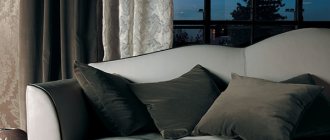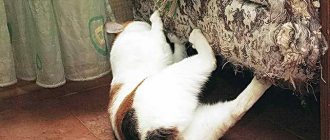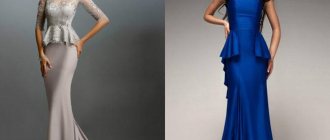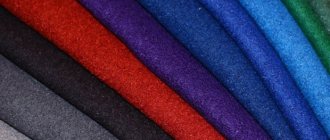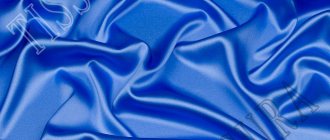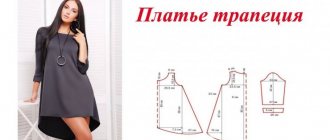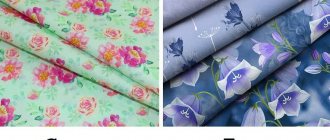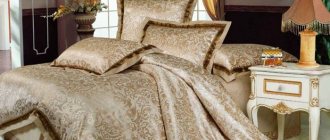What does a bride pay attention to first when choosing a wedding dress? Of course, on the style and fabric. Usually girls know in advance which material is preferable for them. Those who dream of a classic look will probably choose satin, silk, chiffon or lace. Original brides can turn their attention to fabrics such as jacquard, velvet or even denim.
Advertising - Continued below
We invite you to consider the most popular “wedding” and not so popular fabrics in more detail: and learn about their features, pros and cons.
Satin wedding dresses
Atlas. Photo: Crafts Fair, fabric store “Emerald Owl”
Satin wedding dress. Photo: sv-valens.ru
Satin is one of the most popular materials for wedding dresses. Literally from Arabic this word is translated as “smooth”. The shiny surface of satin wedding dresses has attracted brides throughout the 20th century. Satin is sometimes even called wedding dress fabric. This lightweight and pleasant-to-touch material is suitable for almost all classic wedding styles.
Satin is the best fabric for summer wedding dresses
Satin is one of the classic materials for sewing elegant clothes; it can be considered one of the best fabrics for wedding dresses.
Satin is a soft and flowing fabric, so it is often used for fitted dresses or wedding dresses that are not intended to be voluminous. Satin has a bright pearl sheen, which adds solemnity and showiness to even the most modest outfits made from this material. You can also use satin fabric to make the basis of a wedding dress - the cover of a dress, the second layer of a skirt, a bodice, and top it off with transparent lush frills or flounces made of mesh materials or lace. This combination looks flirty, but at the same time allows you to clearly form the silhouette of the product.
The satin is laconic and not flashy, but at the same time it is capable of creating truly rich wedding images. Satin dresses are restrained, modest and perfectly highlight the natural beauty of the bride. Satin items are light, quite elastic and very comfortable to wear, so satin will be an ideal fabric for sewing a wedding dress for an outdoor celebration outside the city.
Advantages
- The satin is distinguished by a characteristic shine of the surface, which is ensured by the exceptional density and special structure of the weave of the fabrics.
- Draps well, forms seductive soft folds on dresses.
- Perfectly combined with details made from fabrics of complex texture and decorative items.
- Emphasizes the graceful curves of the figure and adds femininity to the image.
- Low price - from 2.5 dollars per m.p.
Flaws
- High-quality thick satin may be uncomfortable in hot weather, because... due to its structure, it is poorly ventilated.
- Any defects and contamination are more noticeable than on materials with complex textures.
- Satin is insidious and can emphasize both the advantages and disadvantages of the silhouette, therefore it is suitable only for the slenderest brides.
Select satin for wedding dresses in the catalog ->
Tulle wedding dresses
Fatin
Wedding dress with a full tulle skirt. Photo: olga-welling.ru
Tulle is in second place in popularity. It is also used when sewing classic styles such as “Princess” or “Mermaid”. Tulle is a translucent and lightweight fabric that, when applied in several layers, maintains volume. Tulle wedding dresses can be different: with a multi-tiered or torn skirt, in a classic style or original with tulle flowers.
Advertising - Continued below
Chiffon wedding dresses
Chiffon. Photo: modelyersha.ru
Chiffon wedding dress. Photo: afrodita-sv.ru
Chiffon is a light and almost weightless fabric. Most often, scarves or summer sundresses are made from it. In wedding dresses, chiffon is most often used for decoration. For example, when creating a voluminous cloud for an airy skirt. Chiffon is indispensable if the girl chose a classic ball gown for her wedding. The advantage of this material is its low price. Although a few centuries ago everything was different: chiffon dresses were worn exclusively by royalty and they were very expensive. Today chiffon is available to everyone. At the same time, fluffy chiffon dresses still look great!
Lace wedding dresses
Lace. Photo: itsmyday.com.ua
Lace wedding dress. Photo: sv-valens.ru
Lace wedding dresses are back in trend this season. This luxurious, sexy and at the same time lightweight fabric is loved by fashionistas all over the world. The thing is that lace can look completely different - it all depends on the style. For example, a closed, fluffy dress that has a lace top and a satin skirt will make the bride’s image more modest and noble. A completely lace and tight-fitting wedding dress, on the contrary, turns a girl into a fatal and captivating beauty.
Guipure wedding dresses
Guipure
Guipure wedding dress. Photo: sv-valens.ru
Guipure is a material for graceful and sophisticated brides. It appeared in the 16th century in Italy, when its pattern was in the form of twigs and leaves. Now the patterns may be different, but floral motifs still prevail. Guipure is very often confused with lace; these materials are indeed very similar, the main difference is that synthetic threads are added to guipure. This makes the fabric more durable.
Decorating the hall with fabric: choosing materials
Those who have not yet encountered this issue often do not understand why fabric is needed in decor. But the answer is simple - tables, chairs, arches, walls, etc. are decorated with it.
Designers who have been decorating for many years insist that it is best to combine several types of fabrics at once to create a special festive atmosphere. The most used fabrics for decoration:
- satin that drapes well;
- organza for creating ruffles and bows;
- chiffon is taken in addition to the main fabric;
- taffeta shines spectacularly and is often embroidered with sewn elements; it is used in those places of the hall where stone embroidery looks appropriate;
- lace is used for frills and creates a delicate atmosphere.
What does satin wedding fabric look like
? Interesting. To make the decor look more festive, it is often complemented with fresh flowers, balls, and ribbons.
Denim wedding dresses
Denim fabric. Photo: Nazya.com
Denim dress. Photo: sdress.ru
A denim wedding dress is an original option for an extravagant and fashionable bride. Denim is a symbol of freedom and independence of thought. Today, a dress made of jeans can be found in the wedding collections of popular designers: most often it is used to sew a corset for a dress or to trim a skirt. If you are hesitant to wear such a dress, but you like this fabric, there is a compromise: separate details and elements of the wedding dress. This could be a denim shirt, vest, jacket or brooch.
Brocade
This is another favorite when creating luxurious wedding dresses. Since ancient times, such fabric has been considered a symbol of wealth, since it was made from silk, adding gold threads (now they have been replaced by metal ones). Thanks to this design, the fabric looks very beautiful, it is strong and durable. No additional elements or decorations are required. A brocade outfit is best suited for the cold season. It can beautify a girl with any figure, as it has the ability to successfully demonstrate advantages and hide flaws.
Brocade fabric provides excellent protection from the cold, making it suitable for weddings in the winter and autumn months. A brocade dress complete with a snow-white fur coat will make the newlywed a real queen.
Velvet wedding dresses
Velvet. Photo: mytextile.ru
Velvet dress. Photo: radelya.ru
Velvet has always been considered a royal material; it was used to sew clothes for courtiers and also decorate the palaces of kings. Today velvet is one of the most trendy materials. Gorgeous evening dresses are made from it, and it also fits into winter wedding style. Brides tend to choose velvet wedding dresses in unusual colors: red, green, cream and pale pink. In a white velvet dress in winter, a girl will look like a real Snow Queen.
Advertising - Continued below
Guipure
This translucent fabric with an openwork relief pattern is called Venetian lace. Guipure is often used as an effective addition to chiffon, cotton and linen fabrics, but entire dresses are also made from it. In this case, a lining will be required.
A guipure dress does not require additional finishing or a large number of decorations.
Allure Bridals Wedding dress AB C380 175,000 ₽ Allure Bridals A-line Asymmetry from 150 to 200 thousand Floor-length With corset Provence
Lana Marinenko Wedding dress OW0104 Custom Lana Marinenko A-line Long train Wedding Long sleeve Custom design Prom
Hayley Paige Wedding dress HP 1500 132,300 ₽ Hayley Paige A-line Beach Open back from 100 to 150 thousand Floor-length With a corset For prom
Silk wedding dresses
Silk
Silk wedding dress. Photo: pronovias.com
Silk wedding dresses are a special love of fashion designers around the world. After all, there is, perhaps, no other such sparkling and elegant fabric. Now silk is used to sew dresses in a rustic style. Silk has only two drawbacks: it wrinkles a lot, and can also emphasize figure flaws. Therefore, the bride needs to be more careful when choosing: a silk wedding dress should fit you perfectly.
Organza wedding dresses
Organza. Photo: poshvu.ru
Wedding dress with an organza skirt. Photo: svadbagarderob.ru
Organza is a translucent thin fabric that is woven from several types of fibers. Most often, fashion designers use organza when sewing skirts for wedding dresses. Organza wedding dresses are created for those brides who want to feel like a fairy-tale princess - they look extremely impressive! Very often, organza acts as an additional decoration for a dress - ruffles, flounces, frills. The advantages of organza are that it hardly wrinkles, retains its shape for a long time, is very durable, and at the same time light and pleasant to the touch. There is only one drawback - you need to iron it especially carefully.
Nude mesh is the best fabric for finishing wedding dresses
Mesh is usually called a fairly broad category of materials for sewing, which has several common qualities. These fabrics have a characteristic mesh structure, are very light, transparent, and easy to drape. They rarely have a smooth texture to the touch and can be elastic. This is a translucent material with a pronounced cellular structure without decoration or minimal decoration, often smoothly colored, sometimes with a printed pattern.
If you analyze what fabrics wedding dresses are made from most often, mesh materials will take one of the leading places. Usually, a dress made of mesh has a dense base cover, and the mesh itself is used only for decoration in the form of all kinds of draping elements and decorations. As a rule, decorative elements are manually sewn onto the mesh: lace, rhinestones, beads or ribbons.
The use of flesh-colored mesh with a smooth transition to a lace texture in the areas of the shoulders, back, neckline and sleeves looks unusually gentle. Mesh fabric for wedding dresses is used to disguise fastenings and straps. The material is used to create the effect of “weightless decor”, when the mesh is disguised to match the skin tone, and the decorations sewn onto it hug the bride’s silhouette like a painted pattern. Light mesh to match the dress can also be advantageously combined with corsets and thick fabrics for wedding dresses.
Advantages
- Always elastic and keep their shape well due to their lightness and relative rigidity;
- Convenient for creating decorations on a dress, hair, etc., which allows you to decorate the bride’s outfit in a single ensemble;
- They are easy to wash and, as a rule, do not need ironing.
- Low cost - up to $3 per m.p.
Flaws
- Nets in their modern form are made of synthetics, which can differ significantly in properties from the base material, which makes maintenance somewhat more difficult;
- Cheap meshes can be prone to tightening and sagging under massive decor;
- Difficult to process: stretch mesh is difficult to sew, hand embroidery takes a lot of time.
Select mesh fabric for wedding dresses in the catalog ->
Linen wedding dresses
Linen. Photo: izolna.ru
White linen dress. Photo: dd-shop.ru
Naturalness and naturalness are held in high esteem today! Over the past few years, fashion has increasingly been looking towards simple materials. One of the most popular is linen. Linen wedding dresses are chosen by those who are close to rustic, vintage or Provence style. Suitable styles for this material are sundresses, A-line dresses and loose-fitting dresses.
Advertising - Continued below
The biggest advantage of linen dresses is their hypoallergenicity. In this outfit, any bride will feel comfortable and cozy throughout the entire celebration. Well, and, of course, we must not forget about the touching romantic charm that surrounds any linen wedding dress.
Satin fabric for the best wedding dresses
If, when choosing what fabric to buy for a wedding dress, the bride wants to combine elegance with comfort, then plain satin would be a good choice. Satin can rightfully be considered one of the best fabrics for wedding dresses for any season.
Wedding satin, also known as rolled satin, is much denser and more shape-resistant than regular satin fabric. Satin has a noble pearl shimmer that looks spectacular in the sun. With its help, you can create straight and rigid lines of the dress, fluffy wedding dresses, A-line dresses, stable skirts and corsets for weddings. Minimalistic outfits and strict wedding dresses in the Art Nouveau style look delightful in satin - such an outfit adds royal restraint and aristocracy to the image.
Due to its high density, satin is used to create outfits for the cold seasons. The material does not breathe well, but retains heat well. In addition, rolled satin is quite heavy, so it is not suitable for sewing a wedding dress for a ceremony where the bride will be required to move a lot.
Summer and lighter versions of wedding dresses made of satin fabric are created with bare shoulders, with straps, or in a corset version. Often shortened models of wedding dresses are made from satin, which is also suitable for summer celebrations. The fabric will not disappoint both lovers of rich, lush looks and supporters of more modest and restrained outfits.
Advantages
- Silky shine, softer than satin.
- Tactile pleasantness - not hard, smooth, well ventilated, despite the tight weave.
- Good compatibility with a variety of decor.
- Low cost - the price per meter of high-quality fabric does not exceed $10.
- Suitable for sewing wedding dresses for any season.
Flaws
- Particular care should be taken not to accidentally stain or catch it with something sharp - it will not be possible to quickly remove contamination or defects.
- Natural satin is very comfortable, but wrinkles easily, so you should carefully straighten full skirts when you need to sit in a dress for a long time.
- Any defects and contamination are more noticeable than on materials with complex textures.
Select satin fabric for wedding dresses in the catalog ->
Satin wedding dresses
Satin. Photo: textile-home.ru
Satin wedding dress
Satin is a dense material with a shiny and smooth surface. Sometimes satin is confused with silk or satin: this happens because the basis of the fabric can be different fibers, including silk. But satin, unlike silk, is very durable and almost does not wrinkle.
Other important advantages include that it does not electrify and is pleasant to the touch. Brides who choose satin wedding dresses should remember that in this material any girl will look quite strict and restrained. Therefore, satin is perfect for brides 30+ and those who prefer laconic elegance.
Advertising - Continued below
Photos of wedding dresses made of thick fabric
The newlywed's choice of fabric for her wedding dress subconsciously expresses her emotions. If a girl adheres to traditions, then her choice falls on shape-resistant fabrics such as brocade or satin, which have a dense structure. The rule-free bride will choose flowing crepe or sexy velvet, which are easy to create intricate designs with. But no matter what thick fabric is chosen, the main thing is to guess the cut, size and style, only then the image of the newlywed will be perfect.
Taffeta wedding dresses
Taffeta
Taffeta wedding dress. Photo: rstelle.ru
Taffeta came to us from Persia; this word is translated as “woven.” It is made from twisted threads: the fabric is dense, and at the same time light and thin. A classic A-line taffeta wedding dress is the perfect outfit that will suit any bride, regardless of body type.
Wedding satin
Smooth, shiny. It looks expensive and noble.
- Tight-fitting silhouettes, full skirts, bodices.
Brocade
Shiny fabric. Relief pattern.
- A-line silhouettes, dresses of complex styles
Velvet
Fabric of kings. Soft pile. Made from silk and cotton. Add elastane.
- Capes, jackets, dresses with trains.
For any season
Lace
Delicate, refined. Ideal for a big holiday or a modest celebration.
Chantilly - warm days, guipure, cordova - cool weather.
- Dresses, trim, decorations
Taffeta
Smooth, shiny. Thin - for summer, dense - autumn, winter.
- All types of dresses, draperies, full skirts
Net
Lightweight, transparent.
- Veils, petticoats, ballerina style, veils, jewelry, trim.
Jacquard wedding dresses
Jacquard. Photo: modelyersha.ru
Jacquard wedding dress. Photo: ldweddingculture.com
Jacquard is a smooth, lint-free fabric with a special pattern: it is created by intertwining several threads. These threads can be made from different materials: natural, synthetic or mixed. Wedding dresses made of silk jacquard look especially impressive.
The advantages of this fabric: strength, wear resistance and durability. Of the minuses: jacquard wedding dresses have a high price. By the way, it is believed that jacquard is the ideal fabric for a short wedding dress.
